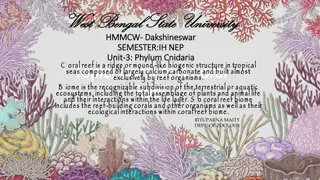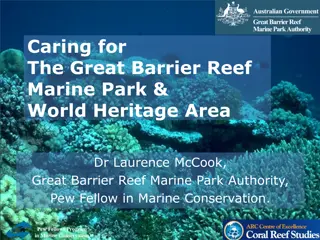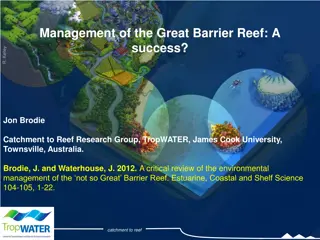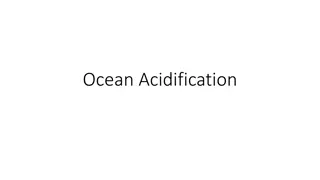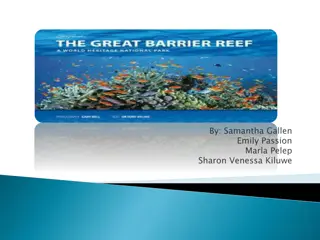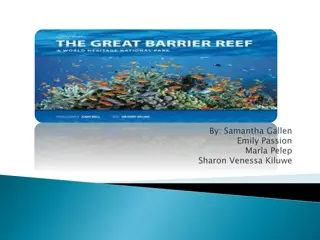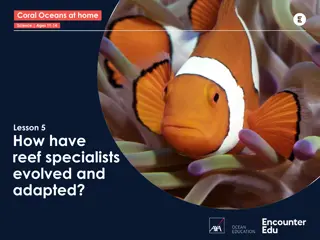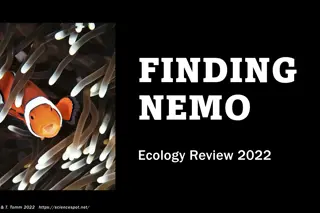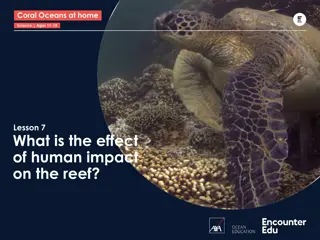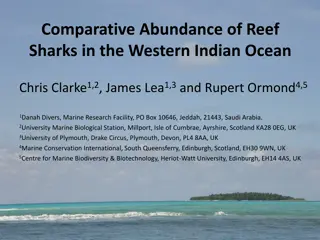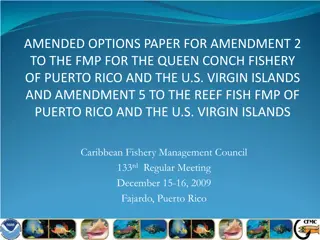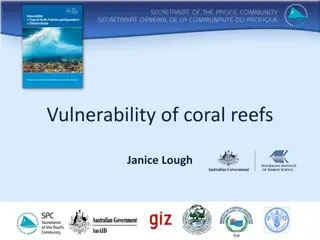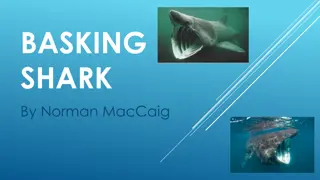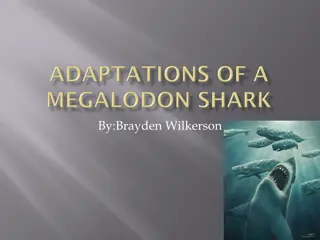Impacts of Shark Removal on Coral Reef Dynamics
This study delves into the repercussions of shark removal on the intricate ecosystem of coral reefs. It explores the correlation between shark abundance, reef fish community structure, benthic disturbances like cyclones and bleaching, and the synergistic effects of top-down and bottom-up processes. The research highlights the significant role of sharks in maintaining coral cover and the trophic structure of fish communities in coral reefs subjected to both natural disturbances and human activities like fishing.
Download Presentation

Please find below an Image/Link to download the presentation.
The content on the website is provided AS IS for your information and personal use only. It may not be sold, licensed, or shared on other websites without obtaining consent from the author.If you encounter any issues during the download, it is possible that the publisher has removed the file from their server.
You are allowed to download the files provided on this website for personal or commercial use, subject to the condition that they are used lawfully. All files are the property of their respective owners.
The content on the website is provided AS IS for your information and personal use only. It may not be sold, licensed, or shared on other websites without obtaining consent from the author.
E N D
Presentation Transcript
Taken out of context: the effects of shark removal in the dynamic environment of a coral reef Jonathan L.W. Ruppert, Mike Travers, Marie-Jos e Fortin and Mark G. Meekan
Coral Reefs: Human Activity or TopPredators? High numbers sharks high coral cover, absent low coral cover Changes in trophic structure of fish communities Confounding of human activity (fishing down food chain) and natural disturbance Sandin et al. 2008 PLoS ONE
Aims 1. 2. Does fishing impact shark abundance? Do changes in the abundance of sharks affect the structure of the reef fish community? How do benthic disturbances (cyclones, bleaching) alter fish communities? Are there synergistic effects of these top-down and bottom-up processes? 3. 4.
Ashmore (Fished) Rowley Shoals (Non-Fished) Scott Reefs (Fished)
Fished Reefs: Coral Bleaching 80 South Scott North Scott Seringapatam Coral Cover (Mean 95%CI) 60 40 20 0 1994 1996 1998 2000 2002 2004 2006 2008
Non-Fished Reefs: Cyclonic Event 80 Mermaid Clerke Imperieuse Coral Cover (Mean 95%CI) 60 40 20 0 1994 1996 1998 2000 2002 2004 2006 2008
Treatments: Fishing and Disturbance Fishing (Fished vs. Non-Fished) Shark density differences between Rowley and Scott Scott Reefs Rowley Shoals 80 Coral Cover (%) 60 Disturbance (Disturbed vs. Non-Disturbed) < 30% coral cover threshold 40 30% Coral Cover 20 0 1994 2001 2008
Shark Community Data: BRUVS BRUVS (Baited Remote Underwater Video Station) All reefs (2003/2004) Target apex predators & carnivores Depth range: 5 100 m 1 to 1.5 hrs per drop MaxN statistic
Trophic Structure of Coral Reef Fishes AIMS LTMP (Long-Term Monitoring Program) Scott and Rowley (1994 Present) 6 reefs; 3 sites each (n=18) Northeast reef slope Benthic surveys alongside Abundance counts (18 families; non-cryptic species; excludes recruits) SOURCE: AIMS
Results: Shark Density (permuted ANOVA) 1.6 n = 94 = 9 p < 0.01 1.4 Sharks Hour (mean 95% CI) 1.2 1 n = 46 = 5 n = 28 = 5 0.8 0.6 0.4 0.2 0 Ashmore Reef Scott Reef Rowley Shoals
Differences in Trophic Structure (RDA) 1 0.6 Fished/Disturbance Fished/No Disturbance Non-Fished/Disturbance Non-Fished/No Disturbance Fished vs. Non- Fished: Carnivores & Herbivores (Territorial & Non Territorial) Detritivore 0.4 Carnivore 0.2 RDA 2 (9.5 %) 0.0 0 RDA2 -0.2 Herbivore Herbivore_T Disturbance vs. Non-Disturbance: Herbivores, Planktivores, Corallivores, and Detritivores Planktivore Corallivore -0.4 -0.6 -1 -0.8 -0.5 0.0 0.5 RDA 1 (13.6 %) RDA1
Trophic Group Responses: Carnivores * 60 Density Km-2 (mean 95%CI) 50 * p < 0.05 ** p < 0.01 40 Fished/Disturbance Fished/No Disturbance Non-Fished/Disturbance 30 Non-Fished/No Disturbance 20
Trophic Group Responses: Herbivores 1000 ** ** Density Km-2 (mean 95%CI) * 850 * p < 0.05 ** p < 0.01 700 Fished/Disturbance Fished/No Disturbance Non-Fished/Disturbance 550 Non-Fished/No Disturbance 400
Trophic Group Responses 120 80 ** ** ** Density Km-2 (mean 95%CI) 50 80 20 40 Corallivore ** Detritivore 2200 ** Fished/Disturbance Fished/No Disturbance Non-Fished/Disturbance Non-Fished/No Disturbance 1500 800 Planktivore
Summary 1. Does fishing impact shark abundance? YES 2. Do changes in the abundance of sharks affect the structure of the reef fish community? YES Meso-predator release of carnivores andsubsequent trophic cascade during disturbances with herbivores 3. Do benthic disturbances alter fish communities? Are there synergistic effects of top-down and bottom-up processes? YES Herbivores, planktivores and corallivores show responses to changes in coral and algal cover Detritivores show synergistic responses
Significance: Resilience Herbivores more abundant on unfished reefs where more sharks are present Central to recovery of reefs from processes that result in the loss of coral cover Implications for reef resilience
Acknowledgements Funding/Data Field/lab assistance Dr. Jim Underwood Mike Cappo AIMS Monitoring Team Conrad Speed Owen O Shea Rachelle Ninio Places Helpful Insights Dr. Donald Jackson Dr. Brian Shuter





